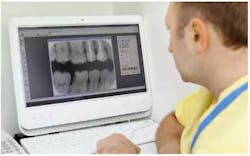It’s crucial for practices to embrace the highest levels of technologies available because our era is advancing so quickly that if they don’t keep up, their competition will. Storing digital files in the cloud is the most progressive method of data storage technology available for dentists and orthodontists today, yet for many practices, the cloud can seem as difficult to comprehend as a cloud itself.
ADDITIONAL READING |Why you need to move your dental practice to the cloud
The cloud is more than just a fleeting, floating technology trend. It is a main player for current and future methods of data storage, and its effects have already transformed the businesses across many sectors, including financial, technology, and retail companies. The adoption of the cloud is widely apparent in individual consumers who use services such as Apple, Netflix, and Amazon or store personal data on iCloud, Dropbox, or Google Drive. Now the time has come for the cloud to expand its reach into the medical and dental fields.
Although many acknowledge the wide reach of the cloud, as a dental professional, you should also understand what the cloud is, how it works, and realize the benefits and risks of using the cloud in your dental practice. A basic definition of the cloud is an Internet-based space where services store data. Being “in the cloud” means making the switch from storing data on hardware to storing it with a cloud-based service provider.
Why is this important to dentists and orthodontists? For the health-care sector, securing patient files is the primary function of data storage. Cloud services offer HIPAA-compliant data-storage solutions that are flexible and responsive to memory storage needs. Storing data in the cloud not only makes work easier for dentists and orthodontists, but it also makes treatment more reliable and effective for patients. Patients have responded positively to the implementation of cloud storage for their files so far. According to research from The Mount Sinai Medical Center, patients find cloud storage more effective and quicker than previous storage methods.
It can be hard to keep up with the latest hardware and software when you have patients to attend to and treatments to oversee. Luckily, the cloud is easy to implement and eliminates the need to overhaul devices just to update for storage needs. You can add memory instantly according to your storage needs, and the cloud reduces overall IT costs, because when you pay a cloud data provider, you are also investing in their IT services.
The cloud is proving to be an effective model of data storage in the health-care system because of its security, flexibility, and value, and it’s not showing signs of slowing down its reach. In fact, Box, a major cloud provider, recently announced that it secured 13 new partnerships with digital health vendors (via Venture Beat). The medical field is demonstrating a clear move toward the cloud, and for anyone working in dentistry it’s critical to understand how the current transformations in technology will affect individual practices and the advancement of dental sciences in the future.







